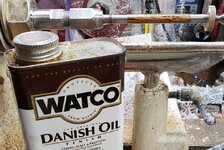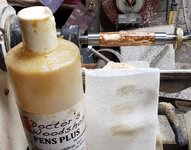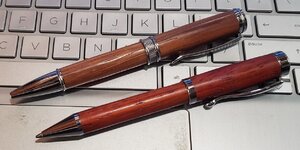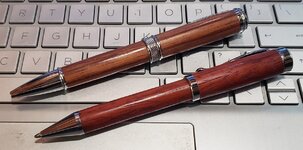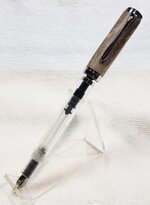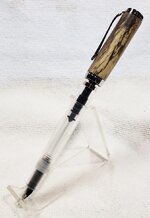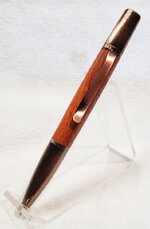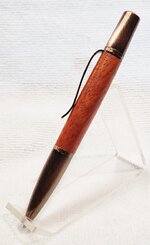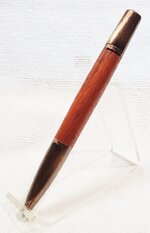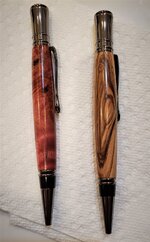I've only been turning pens for a little while. I started last year and turned for about a month, but due to health and lathe issues I didn't really get going again until late May this year. When I first started I used CA glue on most of the pens I made (all slimline). In all honesty, I was dismayed at the results...the CA turned my beautiful wood into plastic!
I started looking for other finishes, and have tried a number of things from O.B. Shine Juice (which actually looks really great, brings out the chatoyance wonderfully, but seems to get sticky when the pen is used), to just shellac, to Myland's Wipe-on Lacquer, to Myland's Friction Polish (which I assume is shellac based). I've settled on the Myland's Friction Polish, and generally it does a good job. It works best, gives the nicest shine, with just a few coats, but I have some concerns about long-term durability. I can put on more coats, but if I do that, I seem to start having problems keeping that nice shine. I can actually get a phenomenal shine with just a single coat of the friction polish, although I usually put on three.
The CA glue is of course very durable, but I have been very disappointed in the very plasticy look it gives my wood pens. I hate to take a really nice natural wood pen and plasticize it, losing all feel of the grain, all depth of the grain, etc. The Mylands friction polish does a pretty good job of coating the wood, but leaving the natural texture in place. It also does a decent job of bringing out that shimmer in the wood.
Bringing out that shimmer is another thing. The shellac/friction polish does a bit, but it seems the thing that brings out the shimmer the most is oil. Is there any robust, durable finish for pens that can bring out the most of the chatoyance, without getting sticky in use?
Thanks!!
I started looking for other finishes, and have tried a number of things from O.B. Shine Juice (which actually looks really great, brings out the chatoyance wonderfully, but seems to get sticky when the pen is used), to just shellac, to Myland's Wipe-on Lacquer, to Myland's Friction Polish (which I assume is shellac based). I've settled on the Myland's Friction Polish, and generally it does a good job. It works best, gives the nicest shine, with just a few coats, but I have some concerns about long-term durability. I can put on more coats, but if I do that, I seem to start having problems keeping that nice shine. I can actually get a phenomenal shine with just a single coat of the friction polish, although I usually put on three.
The CA glue is of course very durable, but I have been very disappointed in the very plasticy look it gives my wood pens. I hate to take a really nice natural wood pen and plasticize it, losing all feel of the grain, all depth of the grain, etc. The Mylands friction polish does a pretty good job of coating the wood, but leaving the natural texture in place. It also does a decent job of bringing out that shimmer in the wood.
Bringing out that shimmer is another thing. The shellac/friction polish does a bit, but it seems the thing that brings out the shimmer the most is oil. Is there any robust, durable finish for pens that can bring out the most of the chatoyance, without getting sticky in use?
Thanks!!

